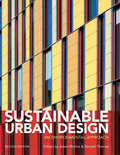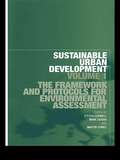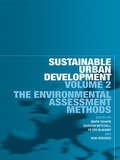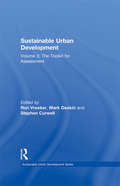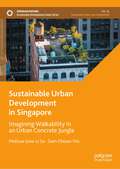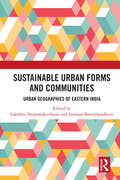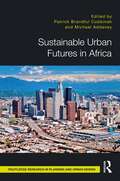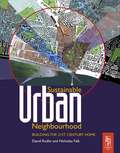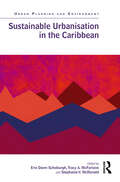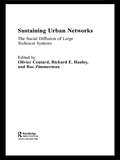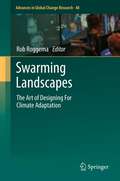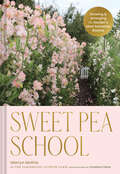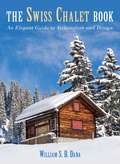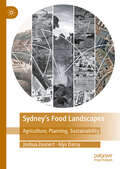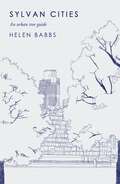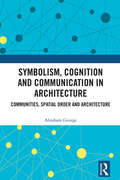- Table View
- List View
Sustainable Urban Design: An Environmental Approach
by Randall Thomas Adam RitchieBy the end of the twenty-first century it is thought that three-quarters of the world’s population will be urban; our future is in cities. Making these cities healthy, vibrant and sustainable is an exceptional challenge which this book addresses. It sets out some of the basic principles of the design of our future cities and, through a series of carefully-selected case studies from leading designers’ experience, illustrates how these ideas can be put into practice. Building on the first edition's original format of design guidance and case studies, this new edition updates the ideas and techniques resulting from further research and practice by the contributors. This book emphasises the enormous progress made towards exciting new designs that integrate good design with resource efficiency.
Sustainable Urban Development Volume 1: The Framework and Protocols for Environmental Assessment (Sustainable Urban Development Series #Vol. 1)
by Mark Deakin Martin Symes Steven CurwellBased on original research, this first volume of a set of groundbreaking new books sets out a framework for analyzing sustainable urban development and develops a set of protocols for evaluating the sustainability of urban development. Protocols included are for sustainable urban planning, urban property development, urban design, the construction, operation and use of buildings. Using these protocols, the book goes on to provide a directory of environmental assessment methods for evaluating the sustainability of urban development and also maps out how these assessment methods are being transformed to evaluate the environmental, economic and social sustainability of urban development. Web-based applications are increasingly being used to support this transformation and the contributors deftly cover this application and issues concerning the use of information and communication technologies for evaluating the sustainability of urban development are also dealt with. With its multidisciplinary approach, Sustainable Urban Development presents key new material for postgraduates and professionals across the built environment.
Sustainable Urban Development Volume 2: The Environmental Assessment Methods (Sustainable Urban Development Series #Vol. 2)
by Peter Nijkamp Mark Deakin Gordon Mitchell Ron VreekerIn this book, the second of a three-volume series, leading authorities on the methodology of environmental assessment provide a unique insight into questions of critical importance to sustainable urban development. Using the framework and protocols set out in Volume 1, Volume 2 examines how well the environmental assessment methods evaluate the ecological integrity of urban development and equity of the resulting resource distribution. The examination focuses on: the instruments of environmental assessment approaches to environmental assessment based in systems-thinking methods for environmental, economic and social assessments their use in evaluating the sustainability of urban development. The Sustainable Urban Development Series contains the research and debate of the BEQUEST (Building, Environmental Quality Evaluation for Sustainability) network funded by the European Commission. Together the books provide a framework, set of protocols, environmental assessment methods and toolkit for policy makers, academics, professionals and advanced level students in urban planning and studies, as well as other areas of the built environment.
Sustainable Urban Development Volume 3: The Toolkit for Assessment (Sustainable Urban Development Series)
by Mark Deakin Ron Vreeker Stephen CurwellThe third volume of the Sustainable Urban Development Series outlines the BEQUEST toolkit that helps link protocol with the assessment methods currently available for evaluating the sustainability of urban development. It details the decision support mechanisms developed for users of the system to guide them in selecting the appropriate assessment methods for a variety of evaluations.This book provides case studies drawn from locations across Europe, and also provides best practice examples demonstrating those protocols that planners, property developers and design and construction professionals have followed, and how they have selected the assessment methods they need to best evaluate the sustainability of cities, districts, neighbourhoods and buildings.
Sustainable Urban Development Volume 4: Changing Professional Practice (Sustainable Urban Development Series #Vol. 4)
by Ian Cooper Martin SymesThis new book explores how the professions responsible for enhancing the built environment's sustainability seek to deliver this new agenda, offering multi-perspective case studies and discussion to argue for a rethinking of the role of urban development professional. Showing how sustainability is rapidly becoming the norm for practitioners, the authors consider new types of professional knowledge, relationships between planning systems and property development, links between public and private sector organisations, ideas about long term responsibilities and new working practices for engaging with the public.
Sustainable Urban Development in Singapore: Imagining Walkability in an Urban Concrete Jungle (Sustainable Development Goals Series)
by Melissa Liow Li Sa Sam Choon-YinThis book offers theoretical and practical insights into land use, transport, and national policies in one of world’s well-known urban concrete jungle, none other than the Singapore city. The emphasis is situated on Singapore’s attempt to promote walking and cycling. Greater appreciation of walkability thrives on Singapore’s rich history, green city, people and the gastronomic kopitiam and hawker culture. The book offers a comprehensive coverage of walkability as a crucial component of urban design to reduce vehicular congestion with the associated carbon emissions, foster a healthy lifestyle and community participation and create jobs to help the economy. A high income per capita and an aging society, lessons drawn from Singapore’s experience will be useful to other societies. Scholars in sustainable tourism field, urban planners, government bodies, tourist boards, entrepreneurs, national parks board, residents, and inbound travellers will benefit from reading the book.
Sustainable Urban Forms and Communities: Urban Geographies of Eastern India
by Sumana Bandyopadhyay Lakshmi SivaramakrishnanThis volume discusses the patterns and trends of urbanization in West Bengal - one of the most urbanized states of India in the early part of the 20th Century. It focuses on the emerging urban landscapes of the state and neighbouring areas on building sustainable urban units and sustainable communities. The book explores the changing urban geographies of the emerging towns of the state and discusses how proper governance can help them to change into sustainable urban units. It presents the historical context of urbanization of West Bengal and traces the factors responsible for the urban primacy of the state. It discusses topics such as the development of the spatial patterns and urbanization, spatial trends of urban growth using remote sensing and GIS techniques, well-being and resilience in the urban society, impact of urbanization on the health status of its citizens, and decentralized governance for inclusive and sustainable development of cities. It also focuses on urban growth, land-use change and its impact on the urban environment. Based on empirical research, this book will be useful for students, teachers and researchers of geography, urban geography, urban studies, urban development and planning, regional planning urban sociology, politics, and urban economics. It will also be of interest to geographers, urban planners, community of geographers, professionals engaged in the discipline, and those interested in the urban geography of West Bengal and eastern India.
Sustainable Urban Futures in Africa
by Patrick Brandful CobbinahSustainable Urban Futures in Africa provides a variety of conventional and emerging theoretical frameworks to inform understandings and responses to critical urban development issues such as urbanisation, climate change, housing/slum, informality, urban sprawl, urban ecosystem services and urban poverty, among others, within the context of the sustainable development goals (SDGs) in Africa. This book addresses topics including challenges to spatial urban development, how spatial planning is delivered, how different urbanisation variables influence the development of different forms of urban systems and settlements in Africa, how city authorities could use old and new methods of land administration to produce sustainable urban spaces in Africa, and the role of local activism is causing important changes in the built environment. Chapters are written by a diverse range of African scholars and practitioners in urban planning and policy design, environmental science and policy, sociology, agriculture, natural resources management, environmental law, and politics. Urban Africa has huge resource potential – both human and natural resources – that can stimulate sustainable development when effectively harnessed. Sustainable Urban Futures in Africa provides support for the SDGs in urban Africa and will be of interest to students and researchers, professionals and policymakers, and readers of urban studies, spatial planning, geography, governance, and other social sciences.
Sustainable Urban Neighbourhood: The Sustainable Urban Neighbourhood
by David Rudlin Nicholas FalkThis successful title, previously known as 'Building the 21st Century Home' and now in its second edition, explores and explains the trends and issues that underlie the renaissance of UK towns and cities and describes the sustainable urban neighbourhood as a model for rebuilding urban areas.The book reviews the way that planning policies, architectural trends and economic forces have undermined the viability of urban areas in Britain since the Industrial Revolution. Now that much post-war planning philosophy is being discredited we are left with few urban models other than garden city inspired suburbia. Are these appropriate in the 21st century given environmental concerns, demographic change, social and economic pressures? The authors suggest that these trends point to a very different urban future.The authors argue that we must reform our towns and cities so that they become attractive, humane places where people will choose to live. The Sustainable Urban Neighbourhood is a model for such reform and the book describes what this would look like and how it might be brought about.
Sustainable Urbanisation in the Caribbean (ISSN)
by Stephanie V. McDonald Dawn Schoburgh, Edited by ErisSustainable Urbanisation in the Caribbean critically examines the socio-geographic context of island states, prioritising the nuanced experiences of Caribbean island states and territories that are largely considered small island developing states (SIDS), against the backdrop of the UN Sustainable Development Goals (SDGs).Increases in urban density place enormous pressure on existing infrastructures and natural resources, exacerbating social inequalities and environmental risks. While the UN SDGs aim to mitigate these risks, the reality of implementing these goals in the context of SIDS is complex. Whereas Sustainable Urbanisation in the Caribbean does not claim to be a comprehensive assessment of policy responses to the SDGs, this edited volume seeks to generate problem-focused, policy-relevant, demand-driven research, thereby permitting the geographical contexts of island states to contribute to the development of proper causal theory about sustainable urbanisation.This book will be of interest to students of public policy, urban sustainability and climate change, as well as government policy analysts, development practitioners, urban planners and UN agencies working in SIDS.
Sustainable Vegetable Production from Start-Up to Market (NRAES #104)
by Vernon P. Grubinger<P>Plan and manage profitable and environmentally friendly vegetable production. <P>Addresses the principles and practices essential to planning, launching, and managing a vegetable production business and the practical implications of sustainability.<P> Thirty-two profiles detail the experiences of individual vegetable growers and provide enterprise budgets for a number of crops.
Sustaining Urban Networks: The Social Diffusion of Large Technical Systems (Networked Cities Series)
by Olivier Coutard Rae Zimmerman Richard E. HanleyConsidering sustainability in its economic, environmental and social contexts, the contributors take stock of previous research on large technical systems and discuss their sustainability from three main perspectives: uses, cities, and rules and institutions.
Swarming Landscapes
by Rob RoggemaThis book advocates a fresh approach to planning that anticipates, rather than reacts to, the changes in climate currently in process. Today's spatial planning procedures rely on historical evidence instead of preparing for factors that by definition lie in the future, yet which are relatively uncontroversial: shortages of water, sea level rise and rises in average temperatures being but three examples. Arguing for more flexibility, the contributors view 'complexity' as the key to transforming the way we plan in order to better equip us to face uncertainties about our future environment.
Swedish Christmas Crafts
by Annika S. Hipple Helene S. LundbergStraight from a country famous for its Christmas celebrations, Swedish author Helene Lundberg goes into detail on everything necessary to make beautiful Christmas crafts with an authentic Swedish twist. This full-color book includes lists of necessary materials, step-by-step pictures of each project, and patterns in the back of the book so you get perfect results with every craft. From stockings, ornaments, and picture frames to creative gift wrappings, Christmas cards, and homemade candles, the simple and elegant projects in this book are easy enough to appeal to beginners, but exquisite enough to make even the newest crafter seem like an expert.
Swedish Christmas Traditions: A Smorgasbord of Scandinavian Recipes, Crafts, and Other Holiday Delights
by Ernst KirchsteigerHere readers will learn how to bring those warm traditions into their own homes, wherever they live. Included are instructions to make mulled wine, homemade peanut brittle, red candied apples, crisp pepparkakor, lightly browned Swedish meatballs, candles, wreaths, and more. Each recipe and project are accompanied by beautiful full-color photographs. From fashioning centerpieces to baking delicious cookies to hand-making Christmas tree ornaments, this book will inspire readers to rediscover the joys of a Scandinavian Christmas.
Sweet Maple: Backyard Sugarmaking from Tap to Table
by Michelle VisserSweet Maple is an instructional book on backyard sugarmaking that&’s also the story of one family&’s connection to the past on a small New England sugar farm. Throughout its pages, Michelle (the &“sugarmaker&’s wife&”) gives advice on:the 22 different kinds of trees that can be tapped. the process of making syrup, to help you decide what level is right for you.how to make alternative treats, such lilac syrup. the health benefits of maple products, which contain more than 40 antioxidants. substituting processed sugar with all-natural maple syrup in any recipe. the 3 steps to making maple sugar.how to make irresistible maple cream and how to enjoy it. While learning the art of sugarmaking alongside her husband, Michelle guides readers through every step of all-natural syrup production, with directions for tapping one tree or dozens, while detailing the life-changing benefits of using maple syrup in the kitchen.Interspersed with sugaring techniques, tips, sidebars, and storytelling, Michelle shares more than 30 of her family&’s tried-and-true maple recipes—from scones to salads.
Sweet Pea School: Growing & Arranging the Garden’s Most Romantic Blooms
by Marryn MathisFrom experienced flower farmer and reigning "Sweet Pea Queen" Marryn Mathis comes this gorgeous, instructive guide to growing and harvesting your own sweet peas. “If you don’t have sweet peas in your garden (yet), having this book on your coffee table is the next best thing.” —Oprah Daily "Sweet Pea School reveals the passion and knowledge of an experienced flower farmer who respectfully acknowledges the work of plantspeople who have grown this beloved bloom into the flowering darling of yesterday, today and tomorrow." —Seattle TimesWith their delicate petals, whimsical vines, and intoxicating scent, sweet peas are some of the most nostalgic and beloved blooms—and they’re easy to grow. Known for the vibrant kaleidoscope of varieties she cultivates on her Washington farm, Marryn Mathis shares her deep knowledge and passion for sweet peas, taking you on an informative journey through her fields and teaching you how to plant, grow, harvest, and arrange a bounty of spectacular flowers. Inspired by Mathis's popular "Sweet Pea School" workshops, this gardening book is a master class in sweet peas, sharing: The history of this timeless flower Best practices for planting and growing An overview of popular varieties Step-by-step instructions for creating magnificent floral arrangements Plus, Mathis’s inspiring personal story of becoming a flower farmer and building The Farmhouse Flower Farm Overflowing with stunning photos of colorful varietals, romantic bouquets, and gardens in full bloom, this modern guide to sweet peas is a must-have resource for gardeners, farmers, and florists of all levels, as well as designers and creatives eager for inspiration.EXPERT AUTHOR: Marryn Mathis (a.k.a. the Sweet Pea Queen) is a champion of and authority on sweet peas. Her Farmhouse Flower Farm is one of the foremost flower farms in the United States, with a robust mail-order business, social media following, and online and in-person workshops that regularly sell out. The farm was featured on the Magnolia Network’s Growing Floret. COMPREHENSIVE FLOWER GUIDE: Sweet peas are beloved for their romantic petals, intoxicating scent, and range of vibrant colors, from pale peach to deep mauve. They're easy to grow—in pots or beds, for cut flowers or your garden—and they attract beneficial pollinators. Sweet Pea School is full of actionable advice and step-by-step instructions for planting, growing, harvesting, and arranging sweet peas, no matter your experience level. Flower farmers and gardeners looking for a hardworking resource and growing guide on sweet peas will find everything they need here. FLOWER LOVERS’ GIFT: Brimming with gorgeous imagery of sweet peas on the vine, the farm at sunrise, and stunning floral arrangements, this volume offers an enchanting peek into the life of a flower farmer. It makes an inspired gift for hobbyists as well as experienced florists and gardeners. Flower lovers, design aficionados, and decorators will delight in the beauty and creative fodder in these pages. Display it on a coffee table alongside a vase or a beautiful tray.Perfect for: Gardeners of all levels Flower farmers, growers, and florists Followers of @thefarmhouseflowerfarm and those who have attended their workshops or buy their seeds People who enjoy flower arranging Interior designers and artists look
Sweetwater's Simple Home: Sew Something Handmade for Every Room, 35 Projects
by Lisa Burnett Karla Eisenach Susan Kendrick&“Sweetwater&’s simple style shines through . . . from a laundry hamper to a covered office chair and quilts for the nursery or the master bedroom.&” —Quilts & More A house becomes a home with handmade touches added to every room. With inspiring designs from the mother-daughter trio behind Sweetwater, it&’s easy to add expressive touches everywhere, from the dining room to the bedroom to the laundry room. Keep it simple and surround yourself with things you absolutely love. 35 beginner-friendly projects, including quilts, pillows, table linens, and accessories—many can be made in a day or lessFresh, modern ideas for making things pretty and practicalBring Sweetwater&’s popular signature style to all your sewing and craft projectsLearn simple, creative techniques for decorating with appliqué, stenciling, stamping, and embroidery&“[A] lovely, lovely book. Actually, even though the projects are all fairly straightforward it&’s one of the nicest quilting books I&’ve looked at in a long while and the photos are fabulous . . . My favorites were the scalloped placemats, the lampshade, the work chair slipcover, tray liner, and some of the bags. All of these are straightforward enough for any beginner, but even for someone whose been sewing as long as I have they would make great additions to brighten up the home.&” —Run Quilt Knit Write&“If you like simple projects with a modern approach, a few (or a lot) of projects in this book will appeal to you . . . All of these projects are &‘beginner-friendly,&’ which is nice for beginners but also nice for those among us who are looking for a fast project (need a quick gift?).&” —Portland Modern Quilt Guild
Swell Holiday
by Cynthia Rowley Ilene RosenzweigEvery day's a holiday in Swellville. But December is the swellest time of all. Coauthors of the breakthrough style manuals, Swell: A Girl's Guide to the Good Life and Home Swell Home: Designing Your Dream Pad, Cynthia and Ilene now bring their signature mix of spirit and style to holiday time. So come on in, brush the snow off your boots, and knock back some chick nog. The Swell girls have been shopping for ideas all year and have their stockings full of ways to rev up the revelry, redeck the halls, and spruce up your holiday look without resorting to reindeer sweaters. No elves required! The girls wrap it all up and tie it with a loopy bow. And if you don't like it, you can always return it.
Swiss Chalet Book: An Elegant Guide to Architecture and Design
by William S DanaHere William S. B. Dana, B.S., presents an in-depth and precise depiction of the breathtaking architectural masterpieces known as the Swiss Chalets. The culmination of elaborate conversations with the designers, the builders, and the experts on these spectacular buildings, here is a piece of design history that is not to be missed.A style of German origin, Swiss Chalets were best known for their large windows, ornate carvings, and balconies. Often they were brightly painted, and had gabled roofs with great overhanging eaves. These stunning aristocratic homes decorated the Swiss countryside in the nineteenth century, and later could be seen throughout the rest of the world. New Chalets, as they were called, rose up in Norway and Sweden, and finally even crossed the Atlantic, appearing in places as unexpected as Ohio and New Jersey.Through delicate language and lines, Dana expresses both the science and the art behind the simple structural elements and the most complex details of the chalets. This book, a 1913 original, displays diagrams, architectural plans, and photographs to best convey the different fundamentals and models of Swiss Chalets. The author’s research of this beautiful art form cultivates knowledge and appreciation of this great architectural style.
Switched Reluctance Motor Drives: Fundamentals to Applications
by Berker Bilgin, James Weisheng Jiang and Ali EmadiElectric motors are the largest consumer of electric energy and they play a critical role in the growing market for electrification. Due to their simple construction, switched reluctance motors (SRMs) are exceptionally attractive for the industry to respond to the increasing demand for high-efficiency, high-performance, and low-cost electric motors with a more secure supply chain. Switched Reluctance Motor Drives: Fundamentals to Applications is a comprehensive textbook covering the major aspects of switched reluctance motor drives. It provides an overview of the use of electric motors in the industrial, residential, commercial, and transportation sectors. It explains the theory behind the operation of switched reluctance motors and provides models to analyze them. The book extensively concentrates on the fundamentals and applications of SRM design and covers various design details, such as materials, mechanical construction, and controls. Acoustic noise and vibration is the most well-known issue in switched reluctance motors, but this can be reduced significantly through a multidisciplinary approach. These methodologies are explained in two chapters of the book. The first covers the fundamentals of acoustic noise and vibration so readers have the necessary tools to analyze the problems and explains the surface waves, spring-mass models, forcing harmonics, and mode shapes that are utilized in modeling and analyzing acoustic noise and vibration. The second applies these fundamentals to switched reluctance motors and provides examples for determining the sources of any acoustic noise in switched reluctance motors. In the final chapter two SRM designs are presented and proposed as replacements for permanent magnet machines in a residential HVAC application and a hybrid-electric propulsion application. It also shows a high-power and compact converter design for SRM drives. Features: Comprehensive coverage of switched reluctance motor drives from fundamental principles to design, operation, and applications A specific chapter on electric motor usage in industrial, residential, commercial, and transportation applications to address the benefits of switched reluctance machines Two chapters address acoustic noise and vibration in detail Numerous illustrations and practical examples on the design, modeling, and analysis of switched reluctance motor drives Examples of switched reluctance motor and drive design
Sydney’s Food Landscapes: Agriculture, Planning, Sustainability
by Joshua Zeunert Alys DaroyThe story of Sydney’s metropolitan food landscapes is one of dramatic transformations of First Nations land amidst jostles for power and wealth. This book unearths Sydney's lost commercial agriculture since colonisation in 1788 to assess its fragile food futures. Richly illustrated, 270 images are encapsulated within 110 figures, including an array of original metropolitan-scale mappings. Discussion traverses the city’s diverse cultural influences, from Indigenous land management to British pastoralism, Chinese cultivation of Sydney’s “backyard vegetable garden” and southern European farming spawning billion-dollar empires. The region has further been shaped by a vast array of cultural and ideological factors and material practices, with relevance to planning, policy, ethics, geography, heritage, art, design and technology. This book is the first to bring Sydney’s disparate post-colonial food histories together in one volume to explore the dynamics and tensions between urban growth and food production. The relevance of Sydney’s food landscapes therefore extends far wider than the city itself, with implications for countless regions worldwide in a time of increasing climate and resource precarity.
Sylvan Cities: An Urban Tree Guide
by Helen Babbs"Clever, pretty, fun and informative—what more can a reader ask for?" —Sara Maitland, author, Gossip From the Forest We're surrounded in cities by trees, quiet colossuses that most of us don't know by name. Does that matter? It's certainly possible to appreciate a tree for its beauty, its shade, and its shelter without knowing whether it's an alder, an elder, a lime, or a beech. But look harder, and we begin to see the beauty beneath the bark—the tales of how trees are integral to medicine and art as they are furniture and firewood; the stories of why wild figs grow on the banks of Sheffield's rivers and why the ash tree is touched with magic and mischief. As well as being an illustrated guide that will help you identify some of the species you see around town every day, Sylvan City is also a potted-journey through our cities' woody places and a literary hunt for where their wild things are. Inviting readers on an intricately illustrated journey into the urban forest, Sylvan City is both a practical guide to identifying 20 of the most common trees standing sentry on our street corners, and a lyrical, anecdotal treasure trove of facts and history, culture, and leafy lore.
Symbolism, Cognition and Communication in Architecture: Communities, Spatial Order and Architecture
by Abraham GeorgeThis book discusses the role and significance of symbols and symbolism in graphical communication toward the establishment of meaningful architecture. It explores how these are effectively applied in architectural education for the empowerment of learners in various cultures around the world. The volume examines the developments in graphic representations while recognizing the importance of cognition and its perception in spatial terms. In a scenario where architectural education is at crossroads, facing challenges of a global nature, this book highlights the importance of understanding architectural curriculum and design subjects. The author discusses the issues of communicating the knowledge of architecture to heterogeneous groups of students and explains how design fields and learning in architecture can be modified through cognitive instructional methods. The book outlines the methodology to develop symbols and symbolic pedagogical tools for effective communication in architecture. The book will appeal to students, researchers, teachers and scholars of architecture, design, planning and visual communication. It will also be of interest to architects, artists, spatial designers, town planners, urban planners and professionals.
Symbols, Signs and Signets
by Ernst LehnerReproducing in historical sequence 1355 signs, seals, and symbols from the simplest drawings of heavenly bodies, through the intricate heraldic devices of the Middle Ages, to modern cattle brands and hobo sign language, this book will be of immense value to the commercial artist and designer. The development of man as an artist and designer is here recorded pictorially by one of the world's foremost experts in the field of graphic art, Ernst Lehner.This book is divided into 13 sections, each with a separate brief introduction: Symbolic Gods and Deities (Egyptian, Babylonian, Greek, Germanic, Incan, Aztec, Hindu, Buddhist, Taoist, etc.); Astronomy and Astrology; Alchemy, Magic, and Mystic (Nordic runes, magic circles, etc.); Church and Religion; Heraldry (coats of arms, badges, etc.); Monsters and Imaginary Figures; Japanese Crests; Marks and Signets (engravers, goldsmiths, armorers, stonemasons, etc.); Watermarks (fourteenth-eighteenth centuries); Printer's Marks (fifteenth-seventeenth centuries); Cattle Brands; and Hobo Signs. All the signs, symbols, and signets are pictured in black and white on strikingly laid out pages, with full explanatory notes for both lay readers and specialists.Anyone interested in means of communication other than language will find this book fascinating and authoritative. The student and teacher in the graphic arts will find it a practical visual guide through the transformation of simple marks and signs into the complicated emblems of our time.
